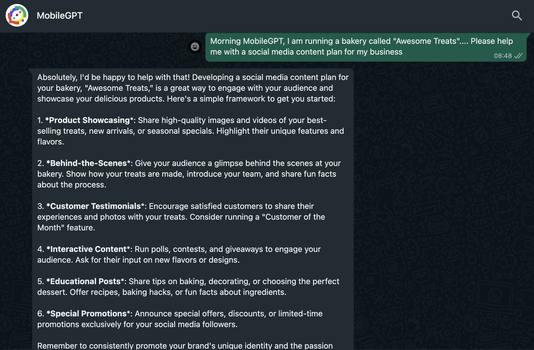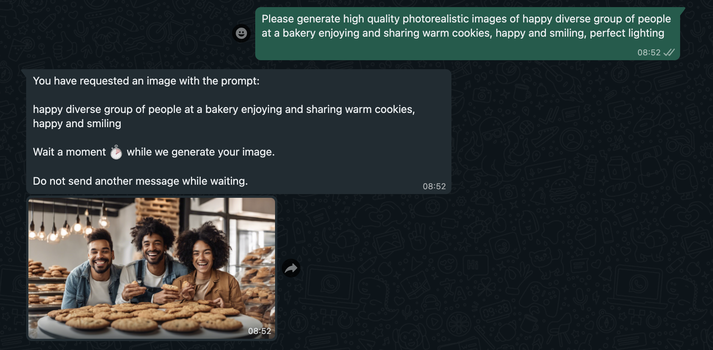Generative AI refers to artificial intelligence systems that are capable of generating new content, such as images, texts, or even music, based on input data or patterns it has learned. These AI models utilize techniques like Generative Adversarial Networks (GANs) or Variational Autoencoders (VAEs) to produce new and original output.
Most business owners worry about the safety of AI generated content: is it safe to use in my business? is it plagiarised content?
The short answer is that AI-generated content is original and created by artificial intelligence. This content is not plagiarized, and as the user who facilitated its creation, you hold the rights to it. Typically, such content requires some editing and refinement. The purpose of AI is not to produce your content in its entirety but to provide a solid foundation. The creative input and structuring primarily stem from the human utilizing the AI.

This blog will discuss:
- What can Generative AI do for your business
- 10 steps to help you seamlessly integrate generative AI into your business
- How to get started with MobileGPT
What Can Generative AI Offer Your Business
Generative AI stands at the forefront of technological innovation, offering a myriad of opportunities for businesses. As we delve into this transformative era, it's essential to understand the multitude of ways Generative AI can revolutionize your business operations.
1. Creative Content Generation: The power of Generative AI extends into creative realms such as content creation. Whether it's crafting compelling blog posts, engaging social media content, or innovative marketing materials, AI tools like MobileGPT can generate high-quality content tailored to your brand's voice and audience's preferences. This not only saves time but also injects a fresh, creative perspective into your content strategy.
For example, say you are a small business looking to get content for social media but need a boost, MobileGPT can help:
In the first screenshot, we ask MobileGPT for ideas around content planning:

Once we have a response, we can try getting AI to generate some creative images, this image below took us 2 tries. With a subscription to MobileGPT, you have unlimited tries to get the perfect AI image. Also read this: How to write image generation prompts for AI.

You can now use MobileGPT to generate most of the ideas from the content plan.
2. Streamlined Document Generation: For businesses inundated with paperwork, Generative AI can be a game-changer. From generating reports to drafting emails and creating business proposals, AI can streamline these tasks, ensuring accuracy and consistency, while freeing up valuable human resources for more strategic tasks.
MobileGPT document generation feature has been upgraded to generate even more detailed and professional document, you can generate documents for:
- Sales proposals
- Project plans
- Business documents
- Blogs
- HR documents
- Letters
- Memos
- Emails
And much more, just give it a try.
3. In-House Training and Development: Generative AI can also play a pivotal role in employee training and development. By creating personalized training modules and interactive learning experiences, AI can help in upskilling employees, thus enhancing their productivity and engagement.
Gone are the days of standardised training modules, now AI can create in seconds a full lesson plan for any topic. Upskill your team with AI, provide them with a lesson topic and let AI to the rest, here is an example of a lesson plan generated on MobileGPT.

4. Image Generation and Design: For businesses seeking creative visual content, Generative AI tools can produce high-quality images and designs. This capability is invaluable for creating marketing materials, product prototypes, and more, offering a cost-effective and efficient solution for visual content creation.
10 Steps to Implement Generative AI in Your Business Seamlessly
Assess Your Business Needs
- Begin by thoroughly evaluating different aspects of your business to pinpoint areas where AI can add the most value. Consider factors like time-consuming tasks, customer engagement, content generation, and administrative efficiency. A detailed assessment helps in identifying the specific problems that AI can solve.
- Imagine you run a small e-commerce business. Upon assessment, you might discover that a significant amount of time is spent answering repetitive customer queries. Implementing an AI tool like MobileGPT could automate these interactions, allowing your team to focus on more complex and revenue-generating activities.

Understand the Capabilities of AI Tools
- Research the functionalities and limitations of various AI tools. Understanding the scope of tools like ChatGPT and MobileGPT is crucial in aligning them with your business needs. This involves exploring their capabilities in areas like conversation automation, content creation, and data analysis.
- For a small content creation agency, delving into MobileGPT's abilities to generate diverse content formats could reveal opportunities to enhance service offerings. For instance, learning that MobileGPT can efficiently create SEO-optimized blog posts and visually appealing social media content could transform the agency's workflow.
Set Clear Objectives
- Clearly define what you aim to achieve with AI integration. Objectives should be specific, measurable, achievable, relevant, and time-bound (SMART). This step is about setting tangible targets that AI can help accomplish.

- A local bookstore planning to use AI might set an objective to increase online sales by 20% over six months through AI-driven personalized email marketing and social media campaigns.
Choose the Right AI Tools
- Select AI tools that align with your specific objectives and business context. This involves considering factors like the tool’s compatibility with your existing systems, ease of use, scalability, and cost.
- A small legal practice might choose an AI tool that not only automates document creation but also integrates with their existing case management system, ensuring a seamless workflow transition.
Plan for Integration
- Develop a strategy for integrating the chosen AI tools into your current business processes. This plan should include technical setup, data input, system compatibility checks, and a timeline for implementation.
- A boutique fitness studio planning to integrate AI for client management and workout scheduling would need to ensure that the AI tool syncs with their existing client database and booking system without disrupting current operations.
Train Your Team
- Provide comprehensive training to your team on how to use the new AI tools. This includes understanding the tool’s features, benefits, and practical applications in daily business operations.
- A small marketing firm integrating an AI tool for content generation would conduct training sessions to help their writers and strategists understand how to use the AI for initial drafts, which they can then refine and personalize.
Start with a Pilot Project
- Implement AI on a small scale initially. Choose a specific project or business area to apply AI. This approach allows you to observe the tool’s impact and make necessary adjustments before a wider rollout.
- A local cafe might start by using an AI tool to manage their social media inquiries and gauge customer responses before employing the tool for broader marketing and customer service tasks.
Monitor and Measure Performance
- Regularly track and analyze the performance of the AI tools against your set objectives. Use quantitative metrics and qualitative feedback to gauge effectiveness.
- A consulting firm using AI for appointment scheduling and document automation would monitor metrics like time saved, error reduction, and client feedback to evaluate the tool’s impact.
Gather Feedback and Iterate
- Continuously collect and incorporate feedback from employees and customers. This feedback is essential for making iterative improvements to how AI is used in your business.
- A small online retailer could gather customer feedback on the AI-driven chat support’s effectiveness, using insights to refine the chatbot’s responses and improve user experience.
Scale and Expand Use
- Based on the success of the initial implementation, gradually expand the use of AI across other business areas. Consider scaling up the AI's capabilities or integrating additional AI tools as needed.
- A graphic design studio, after successfully using AI for basic image generation tasks, might decide to expand its use to more complex design projects or integrate an additional AI tool for project management.
Get started with MobileGPT
The beauty of modern AI tools like MobileGPT lies in their accessibility and ease of use. Getting started is simpler than you might think, and it all begins with something as familiar as WhatsApp.
Embrace Simplicity with MobileGPT: MobileGPT stands out for its user-friendly interface and seamless integration into everyday business communications. To embark on your AI journey, all you need is the WhatsApp application—a platform already widely used for business communications worldwide.
Step-by-Step Guide to Get Started:
- Download WhatsApp: If you haven’t already, download and set up WhatsApp on your mobile device or desktop. It’s available on both iOS and Android platforms.
- Contact MobileGPT: Once WhatsApp is set up, the next step is to reach out to us. You'll simply send a message to our dedicated MobileGPT number. This number will be your gateway to accessing a wide range of AI-powered services. Use this link: https://wa.me/message/TRQTFU2TZDBGP1
- Begin Your AI Journey: After sending a message to the MobileGPT number, you will receive a prompt response. From there, you can start exploring the various functionalities of MobileGPT. Whether it's generating content for your blog, creating infographics for your next presentation, or even drafting documents, MobileGPT is equipped to assist.
- Customize Your Experience: As you become more familiar with MobileGPT, you'll discover the flexibility to tailor its services to your specific business needs. This customization ensures that the AI tool aligns perfectly with your business objectives, enhancing productivity and creativity.
A World of Possibilities at Your Fingertips: Imagine being able to manage content creation, customer interactions, and even internal training programs, all through a simple chat interface on your phone or computer. MobileGPT brings this vision to life. The ability to harness the power of Generative AI through a platform as ubiquitous as WhatsApp is a game-changer for businesses, especially for small and medium-sized enterprises looking to innovate with minimal disruption.

Taking the Leap: Adopting AI in your business operations doesn't have to be a daunting task. With tools like MobileGPT, the transition can be as straightforward as sending a text message. The journey into the world of AI starts with a single step, and for many businesses, MobileGPT via WhatsApp could be that transformative first step.









